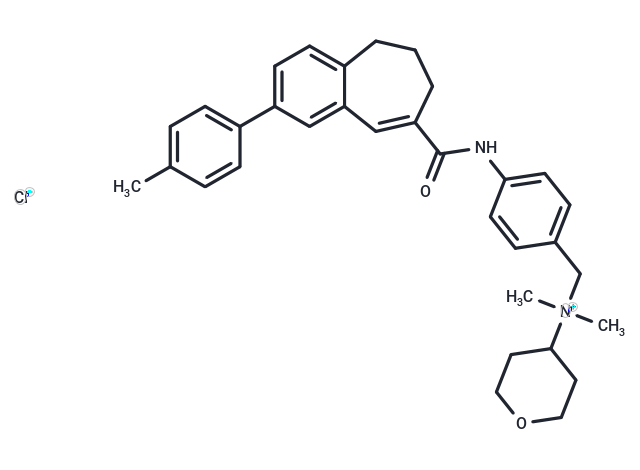Shopping Cart
- Remove All
 Your shopping cart is currently empty
Your shopping cart is currently empty


| Pack Size | Price | Availability | Quantity |
|---|---|---|---|
| 1 mg | $38 | In Stock | |
| 5 mg | $89 | In Stock | |
| 10 mg | $139 | In Stock | |
| 25 mg | $253 | In Stock | |
| 50 mg | $428 | In Stock | |
| 100 mg | $639 | In Stock | |
| 1 mL x 10 mM (in DMSO) | $97 | In Stock |
| Description | TAK-779 (Takeda 779) is an antagonist of chemokine receptor 5 (CCR5), CCR2b, and CXC chemokine receptor 3 (CXCR3). |
| Targets&IC50 | RANTES-CCR5:1.4 nM (in CHO/CCR5 cells), R5 HIV-1 (Ba-L):1.2 nM (EC50, in MAGI-CCR5 cells), R5 HIV-1 (Ba-L):3.7 nM (EC50, in PBMCs), MIP-1α-CCR5:1 nM (in CHO/CCR5 cells), MCP-1-CCR2b:27 nM (in CHO/CCR5 cells), R5 HIV-1 (KK):1.6 nM (EC50, in PBMCs), MIP-1β-CCR5:1 nM (in CHO/CCR5 cells) |
| In vitro | TAK-779 (250 mg/animal per day) inhibits ovalbumin-induced increases in CCR5, CXCR3, IFN-γ, and TNF-α expression in mouse lung, as well as the number of total cells, lymphocytes, and eosinophils in bronchoalveolar lavage fluid (BALF), in a mouse model of asthma[1]. |
| In vivo | TAK-779 increases intestinal allograft survival in a rat model of small intestine transplantation when administered at a dose of 10 mg/kg per day[2]. |
| Alias | Takeda 779 |
| Molecular Weight | 531.13 |
| Formula | C33H39ClN2O2 |
| Cas No. | 229005-80-5 |
| Storage | Powder: -20°C for 3 years | In solvent: -80°C for 1 year | Shipping with blue ice. | |||||||||||||||||||||||||
| Solubility Information | H2O: 16.66 mg/mL (31.37 mM) DMSO: 25 mg/mL (47.07 mM) | |||||||||||||||||||||||||
Solution Preparation Table | ||||||||||||||||||||||||||
H2O/DMSO
| ||||||||||||||||||||||||||

Copyright © 2015-2024 TargetMol Chemicals Inc. All Rights Reserved.